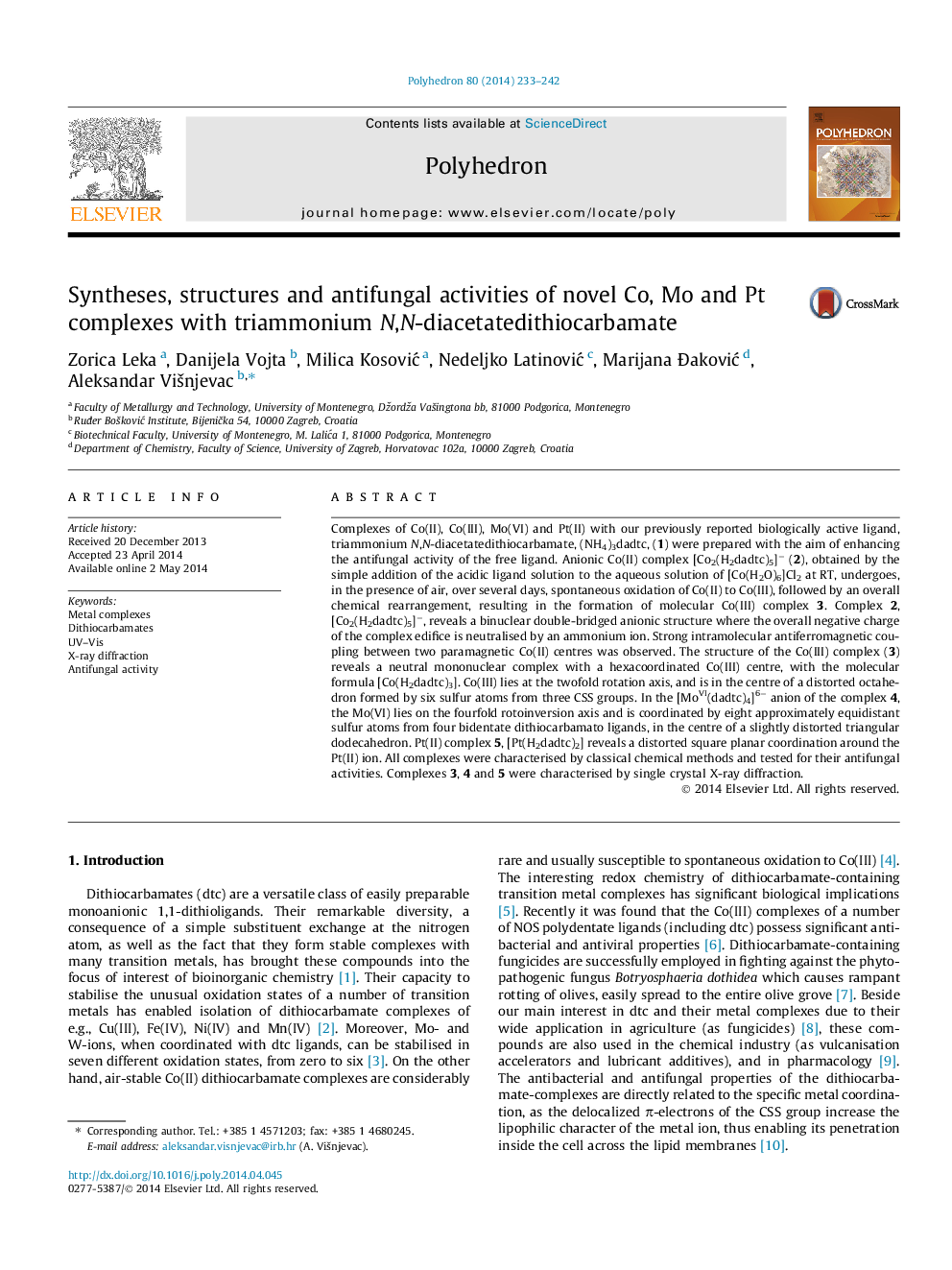| کد مقاله | کد نشریه | سال انتشار | مقاله انگلیسی | نسخه تمام متن |
|---|---|---|---|---|
| 1335305 | 1500259 | 2014 | 10 صفحه PDF | دانلود رایگان |

Complexes of Co(II), Co(III), Mo(VI) and Pt(II) with our previously reported biologically active ligand, triammonium N,N-diacetatedithiocarbamate, (NH4)3dadtc, (1) were prepared with the aim of enhancing the antifungal activity of the free ligand. Anionic Co(II) complex [Co2(H2dadtc)5]− (2), obtained by the simple addition of the acidic ligand solution to the aqueous solution of [Co(H2O)6]Cl2 at RT, undergoes, in the presence of air, over several days, spontaneous oxidation of Co(II) to Co(III), followed by an overall chemical rearrangement, resulting in the formation of molecular Co(III) complex 3. Complex 2, [Co2(H2dadtc)5]−, reveals a binuclear double-bridged anionic structure where the overall negative charge of the complex edifice is neutralised by an ammonium ion. Strong intramolecular antiferromagnetic coupling between two paramagnetic Co(II) centres was observed. The structure of the Co(III) complex (3) reveals a neutral mononuclear complex with a hexacoordinated Co(III) centre, with the molecular formula [Co(H2dadtc)3]. Co(III) lies at the twofold rotation axis, and is in the centre of a distorted octahedron formed by six sulfur atoms from three CSS groups. In the [MoVI(dadtc)4]6− anion of the complex 4, the Mo(VI) lies on the fourfold rotoinversion axis and is coordinated by eight approximately equidistant sulfur atoms from four bidentate dithiocarbamato ligands, in the centre of a slightly distorted triangular dodecahedron. Pt(II) complex 5, [Pt(H2dadtc)2] reveals a distorted square planar coordination around the Pt(II) ion. All complexes were characterised by classical chemical methods and tested for their antifungal activities. Complexes 3, 4 and 5 were characterised by single crystal X-ray diffraction.
Complexes of Co(II), Co(III), Mo(VI) and Pt(II) with our, previously reported, biologically active ligand, triammonium N,N-diacetatedithiocarbamate, (NH4)3dadtc were prepared with the aim of enhancing the antifungal activity of the free ligand. Anionic Co(II) complex [Co2(H2dadtc)5]− (2), undergoes spontaneous oxidation of Co(II) to Co(III), followed by an overall chemical rearrangement, resulting with formation of molecular complex 3. In the [MoVI(dadtc)4]6− anion of the complex 4, the Mo(VI) centre is located at the fourfold rotoinversion axis and coordinated by eight approximately equidistant sulfur atoms from four bidentate dithiocarbamato ligands in the centre of a slightly distorted triangular dodecahedron. Pt(II) complex 5, [Pt(H2dadtc)2] reveals a distorted square planar coordination of the Pt(II) ion. Complexes were characterised by classical chemical methods and X-ray diffraction studies and tested for their antifungal activities. All complexes revealed encouraging levels of antifungal activity when subjected to the tests of mycelia growth inhibition of Botryosphaeria dothidea.Figure optionsDownload as PowerPoint slide
Journal: Polyhedron - Volume 80, 25 September 2014, Pages 233–242